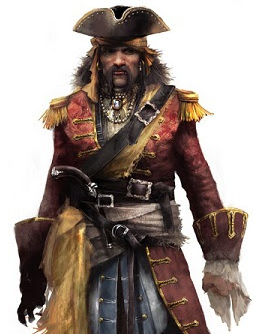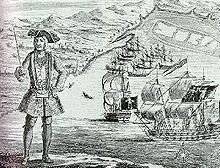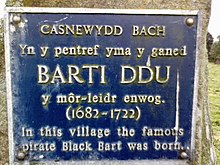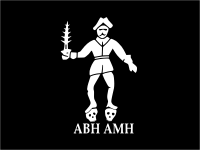
From Wikipedia, the free encyclopedia
| Bartholomew Roberts | |
|---|---|

Bartholomew Roberts at Ouidah with his ship and captured merchantmen in the background.
| |
| Born | 17 May 1682 Casnewydd Bach, Pembrokeshire, Wales |
| Died | 10 February 1722 (aged 39) At sea off Cape Lopez, Gabon |
| Piratical career | |
| Nickname | Black Bart (Welsh: Barti Ddu) |
| Type | Pirate |
| Years active | 1719–1722 |
| Rank | Captain |
| Base of operations | Off the coast of the Americas and West Africa |
| Commands | Royal Rover, Good Fortune, Royal Fortune, Ranger, Little Ranger |
| Wealth | 470 vessels |
Bartholomew Roberts (17 May 1682 – 10 February 1722), born John Roberts, was a Welsh pirate who raided ships off the Americas and West Africa between 1719 and 1722. He was the most successful pirate of the Golden Age of Piracy as measured by vessels captured,[1] taking over 400 prizes in his career.[2] He is also known as Black Bart (Welsh: Barti Ddu), but this name was never used in his lifetime.[3] He is sometimes confused with Charles Bolles, called the "Black Bart" of the American West.
Early life
He was born John Roberts in 1682 in Casnewydd-Bach,[4] between Fishguard and Haverfordwest in Pembrokeshire, Wales. His father was most likely George Roberts.[5] It's not clear why Roberts changed his name from John to Bartholomew,[6] but pirates often adopted aliases. He may have chosen his first name after the well-known buccaneer Bartholomew Sharp.[7] He is thought to have gone to sea when he was 13 in 1695, but there is no further record of him until 1718, when he was mate of a Barbados sloop.[8]
In 1719, Roberts was third mate on the slave ship Princess under Captain Abraham Plumb. In early June that year, the Princess was anchored at Anomabu (then spelled Annamaboa, which is situated along the Gold Coast of West Africa, present-day Ghana) when she was captured by pirates. The pirates were in two vessels, the Royal Rover and the Royal James, and were led by captain Howell Davis. Davis, like Roberts, was a Welshman, originally from Milford Haven in Pembrokeshire. Roberts and several other of the crew of the Princess were forced to join the pirates.
Davis quickly discovered Roberts' abilities as a navigator and took to consulting him.[9] He was also able to confide information to Roberts in Welsh, thereby keeping it hidden from the rest of the crew.[10] Roberts is said to have been reluctant to become a pirate at first, but soon came to see the advantages of this new lifestyle. Captain Charles Johnson reports him as saying:
Life as a pirate
Commander or commoner?
In the merchant navy, Roberts' wage was less than £4 per month and he had no chance of promotion to captaincy.[citation needed]
A few weeks after Roberts' capture, the Royal James had to be abandoned because of worm damage. The Royal Rover headed for the island of Príncipe. Davis hoisted the flags of a British man-of-war and was allowed to enter the harbour. After a few days, Davis invited the governor to lunch on board his ship, intending to hold him hostage for a ransom. Davis had to send boats to collect the governor, and he was invited to call at the fort for a glass of wine first. The Portuguese had discovered that their visitors were pirates. They ambushed Davis' party on its way to the fort, shooting Davis dead.[12]
A new captain had to be elected. Davis' crew was divided into "Lords" and "Commons", and it was the "Lords" who had the right to propose a name to the remainder of the crew. Within six weeks of his capture, Roberts was elected captain. This was unusual, especially as he had objected to serving on the vessel. Historians believe he was elected for his navigational abilities and his personality, which history reflects was outspoken and opinionated.
Roberts' first act as captain was to lead the crew back to Príncipe to avenge the death of Captain Davis. Roberts and his crew landed on the island in the darkness of night, killed a large portion of the male population, and stole all items of value that they could carry away. Soon afterwards, he captured a Dutch Guineaman, then two days later a British ship called the Experiment. The pirate ship took on water and provisions at Anamboe, where a vote was taken on whether the next voyage should be to the East Indies or to Brazil. The vote was for Brazil.[14]
The combination of bravery and success that marked this adventure cemented most of the crew's loyalty to Roberts. They concluded that he was "pistol proof" and that they had much to gain by staying with him.[15]
Brazil and the Caribbean July 1719 – May 1720
Roberts and his crew crossed the Atlantic and watered and boot-topped[note 1] their ship on the uninhabited island of Ferdinando. They spent about nine weeks off the Brazilian coast but saw no ships. They were about to leave for the West Indies when they encountered a fleet of 42 Portuguese ships in the Todos os Santos' Bay, waiting for two men-of-war of 70 guns each to escort them to Lisbon. Roberts took one of the vessels and ordered her master to point out the richest ship in the fleet. He pointed out the Sagrada Familia, a ship of 40 guns and a crew of 170, which Roberts and his men boarded and captured. The Sagrada Familia contained 40,000 gold moidores and jewelry designed for the King of Portugal, including a cross set with diamonds.[16]
The Rover next headed for Devil's Island off the coast of Guiana to spend the booty. A few weeks later, they headed for the River Surinam where they captured a sloop. After they sighted a brigantine, Roberts took 40 men to pursue it in the sloop, leaving Walter Kennedy in command of the Rover. The sloop became wind-bound for eight days, and when Roberts and his crew finally returned to their ship, they discovered that Kennedy had sailed off with the Rover and what remained of the loot.[17] Roberts and his crew renamed their sloop the Fortune and agreed on new articles, now known as a pirate code, which they swore on a Bible to uphold:[18]
In late February 1720, they were joined by French pirate Montigny la Palisse in another sloop, the Sea King. The inhabitants of Barbados equipped two well-armed ships, the Summerset and the Philipa, to try to put an end to the pirate menace. On 26 February, they encountered the two pirate sloops. The Sea King quickly fled, and the Fortune broke off the engagement after sustaining considerable damage and was able to escape.[19] Roberts headed for Dominica to repair the sloop, with twenty of his crew dying of their wounds on the voyage. There were also two sloops from Martinique out searching for the pirates, and Roberts swore vengeance against the inhabitants of Barbados and Martinique. He had a new flag made with a drawing of himself standing upon 2 skulls, one labelled ABH (A Barbadian's Head) and the other AMH (A Martiniquian's Head)
Newfoundland and the Caribbean June 1720 – April 1721
The Fortune next headed northwards towards Newfoundland, raiding Canso, Nova Scotia,[20] and capturing a number of ships around Cape Breton and the Newfoundland banks. Roberts raided the harbour of Ferryland, capturing a dozen vessels. On 21 June, he attacked the larger harbour of Trepassey, sailing in with black flags flying. In the harbour he discovered 22 merchant ships and 150 fishing ships, all of which were abandoned by their panic-stricken captains and crews, and the pirates were masters of Trepassey without any resistance being offered. Roberts had captured all 22 merchant ships, but was angered by the cowardice of the captains who had fled their ships. Every morning he had a gun fired and the captains were forced to attend Roberts on board his ship; they were told that anyone who was absent would have his ship burnt. One brig from Bristol was taken over by the pirates to replace the sloop Fortune and fitted out with 16 guns. When the pirates left in late June, all the other vessels in the harbour were set on fire. During July, Roberts captured nine or ten French ships and commandeered one of them, fitting her with 26 cannons and changing her name to the Good Fortune. With this more powerful ship, the pirates captured many more vessels before heading south for the West Indies, accompanied by Montigny la Palisse's sloop, which had rejoined them.[21]
In September 1720, the Good Fortune was careened and repaired at the island of Carriacou before being renamed the Royal Fortune, the first of several ships to be given this name by Roberts. In late September, the Royal Fortune and the Fortune headed for the island of St. Christopher's and entered Basse Terra Road, flying black flags and with their drummers and trumpeters playing. They sailed in among the ships in the Road, all of which promptly struck their flags.[22] The next landfall was at the island of St. Bartholomew, where the French governor allowed the pirates to remain for several weeks to carouse. By 25 October, they were at sea again off St. Lucia, where they captured up to 15 French and English ships in the next three days.[23] Among the captured ships was the Greyhound, whose chief mate James Skyrme joined the pirates. He later became captain of Roberts' consort, the Ranger.
During this time, Roberts reportedly caught the Governor of Martinique, who was sailing aboard a 52-gun French warship. The Governor was caught and promptly hanged on the yardarm of his own ship, which the pirates converted into the new Royal Fortune.[24] According to Konstam and Rickman, this reported capture was an embellishment by Captain Charles Johnson in his A General History of the Pyrates.[25]
By the spring of 1721, Roberts' depredations had almost brought seaborne trade to a standstill in the West Indies.[26] The Royal Fortune and the Good Fortune therefore set sail for West Africa. On 18 April, Thomas Anstis, the commander of the Good Fortune, left Roberts in the night and continued to raid shipping in the Caribbean. The Royal Fortune continued towards Africa.
West Africa April 1721 – January 1722
By late April, Roberts was at the Cape Verde islands. The Royal Fortune was found to be leaky, and was abandoned there. The pirates transferred to the Sea King, which was renamed the Royal Fortune. The new Royal Fortune made landfall off the Guinea coast in early June, near the mouth of the Senegal River. Two French ships, one of 10 guns and one of 16 guns, gave chase, but were captured by Roberts. Both these ships were commandeered. One, the Comte de Toulouse, was renamed the Ranger, while the other was named the Little Ranger and used as a storeship. Thomas Sutton was made captain of the Ranger and James Skyrme captain of the Little Ranger.[27]
Roberts next headed for Sierra Leone, arriving on 12 June. Here he was told that two Royal Navy ships, HMS Swallow and HMS Weymouth, had left at the end of April, planning to return before Christmas.[28] On 8 August, he captured two large ships at Point Cestos, now River Cess in Liberia. One of these was the frigate Onslow, transporting soldiers bound for Cape Coast (Cabo Corso) Castle. A number of the soldiers wished to join the pirates, and they were eventually accepted, however they only received a quarter of a pirates pay because they were not sailors most of their lives. The Onslow was converted to become the fourth Royal Fortune.[29] In November and December, the pirates careened their ships and relaxed at Cape Lopez and the island of Annobon.[30] Sutton was replaced by Skyrme as captain of the Ranger.
They captured several vessels in January 1722, then sailed into Ouidah (Whydah) harbour with black flags flying. Ten of the eleven ships at anchor there immediately struck their colours, but were restored to their owners after a ransom of eight pounds of gold dust per ship was paid.[31] The refusal of the eleventh vessel to surrender so enraged was Roberts' crew that, under the cover of night, they climbed aboard and set her on fire.[32] The captured vessels were Slave ships, and the one set on fire had around eighty enslaved Africans on board. They perished either as a result of the fire or by drowning or shark attack after jumping overboard.[31]
Death in battle
On 5 February 1722, Captain Chaloner Ogle of the HMS Swallow came upon the pirate ships Royal Fortune, Ranger, and Little Ranger careening at Cape Lopez. The Swallow veered away to avoid a shoal, making the pirates think that she was a fleeing merchant ship. The Ranger departed in pursuit, commanded by James Skyrme. Once out of earshot of the other pirates, the Swallow opened her gun ports and opened fire. Ten pirates were killed and Skyrme had his leg taken off by a cannonball, but he refused to leave the deck. Eventually, the Ranger was forced to strike her colors and the surviving crew were captured.
On 10 February, the Swallow returned to Cape Lopez and found the Royal Fortune still there. On the previous day, Roberts had captured the Neptune, and many of his crew were drunk and unfit for duty just when he needed them most.[33] At first, the pirates thought that the approaching ship was the Ranger returning, but a deserter from the Swallow recognized her and informed Roberts while he was breakfasting with Captain Hill, the master of the Neptune. As he usually did before action, he dressed himself in his finest clothes:
The pirates' plan was to sail past the Swallow, which meant exposing themselves to one broadside. Once past, they would have a good chance of escaping. However, the helmsman failed to keep the Royal Fortune on the right course, and the Swallow was able to approach to deliver a second broadside. Captain Roberts was killed by grapeshot, which struck him in the throat while he stood on the deck. Before his body could be captured by Ogle, Roberts's wish to be buried at sea was fulfilled by his crew, who weighed his body down and threw it overboard after wrapping it in his ship's sail. It was never found.
Roberts's death shocked the pirate world, as well as the Royal Navy. The local merchants and civilians had thought him invincible, and some considered him a hero.[citation needed]
Pirate Code
Main article: Pirate code
As recorded by Captain Charles Johnson regarding the articles of Bartholomew Roberts.
Aftermath
| Wikisource has original text related to this article: |
The battle continued for another two hours until the Royal Fortune's mainmast fell and the pirates signaled for quarter. One member of the crew, John Philips, tried to reach the magazine with a lighted match to blow up the ship, but was prevented by two men. Only three pirates had been killed in the battle, including Roberts. A total of 272 men had been captured by the Royal Navy. Of these, 65 were black, and they were sold into slavery. The remainder were taken to Cape Coast Castle, apart from those who died on the voyage back. 54 were condemned to death, of whom 52 were hanged and two reprieved. Another twenty were allowed to sign indentures with the Royal African Company; Burl comments that they "exchanged an immediate death for a lingering one".[37] Seventeen men were sent to the Marshalsea prison in London for trial, where some were acquitted and released.
Of the captured pirates who told their place of birth, 42% were from Cornwall, Devon, and Somerset, and another 19% from London. There were smaller numbers from northern England and from Wales, and another quarter from a variety of countries including Ireland, Scotland, the West Indies, the Netherlands, and Greece.[38] Roberts experienced problems with mutinous Irishmen early in his pirate career and was known to generally avoid recruiting Irishmen, to the extent that captured merchant sailors would sometimes affect an Irish accent to discourage Roberts from forcing them into his pirate crew.
Captain Chaloner Ogle was rewarded with a knighthood, the only British naval officer to be honoured specifically for his actions against pirates.[39] He also profited financially, taking gold dust from Roberts' cabin, and he eventually became an admiral.[39]
This battle proved a turning point in the war against the pirates,[40] and many consider the death of Roberts to mark the end of the Golden Age of Piracy.[39]
Personal characteristics
Most of the information on Roberts comes from the book A General History of the Pyrates, published a few years after Roberts' death. The original 1724 title page credits one Captain Charles Johnson as the author. (The book is often printed under the byline of Daniel Defoe on the assumption that "Charles Johnson" is a pseudonym, but there is no proof that Defoe is the author, and the matter remains in dispute.) Johnson devotes more space to Roberts than to any of the other pirates in his book, describing him as:
After his exploits in Newfoundland, a state Governor from New England commented that "one cannot with-hold admiration for his bravery and courage".[citation needed] He hated cowardice, and when the crews of 22 ships in Trepassey harbour fled without firing a shot he was angry at their failure to defend their ships.[citation needed]
Roberts was the archetypal pirate captain in his love of fine clothing and jewelry, but he had some traits unusual in a pirate, notably a preference for drinking tea rather than rum. He is often described as a teetotaler and a Sabbatarian, but there is no proof of this. He certainly disliked drunkenness while at sea, yet it appears that he drank beer.[43]Ironically, Roberts' final defeat was facilitated by the drunkenness of his crew. The Sabbatarian claim arises from the fact that musicians were not obliged to play on the Sabbath – this may merely have been intended to ensure the musicians a day's rest, as they were otherwise obliged to play whenever the crew demanded.
Black Bart was not as cruel to prisoners as some pirates such as Edward Low, but did not treat them as well as did Samuel Bellamy, Howell Davis, or Edward England. Roberts sometimes gave gifts to cooperative captains and crews of captured ships, such as pieces of jewelry or items of captured cargo. He would sometimes ill-use prisoners if he felt that the crew demanded it, but:
In 1997, a book was published that theorized Bartholomew Roberts was a woman transvestite.[45] It was argued that Roberts' corpse was thrown overboard to conceal this fact.
Popular culture
- Bartholomew Roberts is one of four pirate captains mentioned in Robert Louis Stevenson's Treasure Island.[citation needed] In it, Long John Silver says that the surgeon who amputated his leg was one of Roberts' men:
- Several historical novels feature Roberts as the protagonist, including The Devil's Captain (1992) by Philip Shea, The Requiem Shark (1999) by Nicholas Griffin, and The Devil's Captain (2000) by Frank Sherry.
- A number of novels and poems have been published in Welsh featuring Bartholomew Roberts, notably a ballad by I. D. Hooson, for which a vocal score was later composed by Alun Hoddinott, and a novel by T. Llew Jones.
- In the novel The Princess Bride and its film adaptation,[47] protagonist Westley dons the mantle of the Dread Pirate Roberts, a mythical figure inspired by Bartholomew Roberts.
- In the manga series One Piece, a character named Bartholomew Kuma is named for Roberts.[citation needed] The king of the pirates in the series, Gol D. Roger, also resembles Roberts in a number of ways.
- Prominently featured in an episode of the animated television series South Park, the famous Casa Bonita restaurant in Lakewood, Colorado, features an attraction called "Black Bart's Cave", named for Roberts.
- Roberts appears as a non-player character in the Pirates of the Caribbean: At World's End video game, voiced by Fred Tatasciore.
- Roberts appears as the primary antagonist of the 2013 video game Assassin's Creed IV: Black Flag, voiced by Oliver Milburn. In the game, Roberts is reimagined as a "sage", a human reincarnation of the Precursor scientist, Aita.








No comments:
Post a Comment